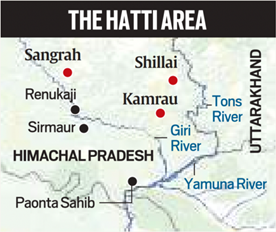

Context
Centre would consider favourably the Himachal Pradesh government’s request for inclusion of the Hatti community in the list of Scheduled Tribes in the state.
About
- The Hattis are a close-knit community who got their name from their tradition of selling homegrown vegetables, crops, meat and wool etc. at small markets called ‘haat’ in towns.
- The Hatti community, whose men generally don a distinctive white headgear during ceremonies, is cut off from Sirmaur by two rivers called Giri and Tons.
- Tons divide it from the Jaunsar Bawar area of Uttarakhand.
- The Hattis who live in the trans-Giri area and Jaunsar Bawar in Uttarakhand were once part of the royal estate of Sirmaur until Jaunsar Bawar’s separation in
- Due to topographical disadvantages, the Hattis living in the Kamrau, Sangrah, and Shilliai areas lag behind in education and employment.
Societal norms of Hattis
- The Hattis are governed by a traditional council called Khumbli, which like the khaps of Haryana, decide community matters.
- The Khumbli’s power has remained unchallenged despite the establishment of the panchayati raj system.
- The two clans have similar traditions, and inter-marriages are commonplace.
- There is a fairly rigid caste system among the Hattis — the Bhat and Khash are the upper castes, while the Badhois are below them.
- Inter-caste marriages have traditionally remained a strict no-no.

Since when have the Hattis been demanding tribal status?
- The community has been making the demand since 1967, when tribal status was accorded to people living in the Jaunsar Bawar area of Uttarakhand, which shares a border with Sirmaur district.
- Their demand for tribal status gained strength because of resolutions passed at various maha Khumblis over the years.


